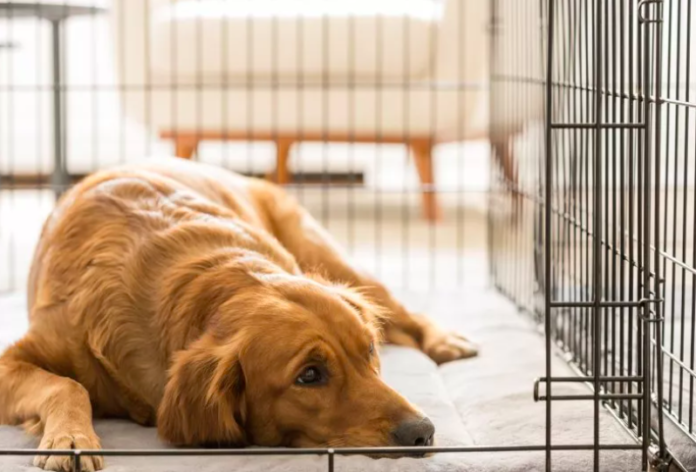Last Updated on October 29, 2023 by Fumipets
What’s the Right Duration to Leave Your Dog Alone at Home? Insights from Experts
Leaving your furry friend at home alone can be a heart-wrenching necessity for many dog owners. Workplaces and establishments often don’t allow our four-legged companions, leaving pet parents to grapple with the question:
How long is too long to leave your dog unattended? Newsweek consulted with a veterinarian and an expert from the American Society for the Prevention of Cruelty to Animals to provide insights into this common pet dilemma.
Understanding Your Dog’s Bladder and Age
Veterinarian Jennifer Fryer from Chewy emphasizes that the duration a dog can remain alone depends on several factors, including their age and bladder control. She explains, “An adult dog can typically wait six to eight hours between outside bathroom trips.” However, for puppies, this timeframe can be as short as one to two hours, gradually extending as they grow older.
Fryer highlights that prolonged solitude can lead to accidents in the house or even urinary tract infections due to holding urine for extended periods. Energetic or anxious dogs may become destructive when left alone, either due to separation anxiety or sheer boredom.
Key Factors for Determining Alone Time
Fryer suggests that dog owners consider several key factors when assessing how long their canine companion can be left at home:
- Bladder Control: Evaluate your dog’s ability to hold their bladder. Some dogs can manage for longer periods, while others may need more frequent bathroom breaks.
- Energy Levels: Consider your dog’s energy levels. Energetic dogs may require more mental and physical stimulation, which might be challenging to achieve during long stretches of solitude.
- Separation Anxiety: Dogs with separation anxiety or a fear of being left alone may struggle with extended periods of solitude.
- Age: Take your dog’s age into account. Senior dogs, typically aged 11 and older, may require more frequent outdoor bathroom breaks and should not be left alone for extended periods.
No One-Size-Fits-All Answer
Fryer emphasizes that there’s no one-size-fits-all answer to the question of how long dogs can be left at home alone. The optimal duration depends on various factors, including individual breed characteristics. Still, she advises against leaving healthy adult dogs alone for more than six hours. Younger and older dogs, as well as those with special needs, should be left alone for shorter durations.
Special Needs Require Expert Support
For dogs with separation anxiety or specific health conditions, Fryer recommends seeking expert guidance to assess the extent of their independence. She notes that such dogs may require a veterinarian’s evaluation to rule out underlying medical issues. These dogs often need special training and, in some cases, medication to cope with solitary periods.
Health Conditions and Individual Breeds Matter
Health conditions can further impact a dog’s ability to remain unattended for extended periods. Conditions such as diabetes, hypothyroidism, kidney disease, and Cushing’s disease can increase water consumption and the need for frequent urination.
For dogs with cognitive dysfunction syndrome, akin to human dementia, prolonged solitude can be especially problematic. These dogs may become confused and disoriented when left alone, which poses potential dangers.
Alternative Solutions for Long Stretches
Owners who have no alternative to leaving their dogs at home alone can explore alternative solutions. Fryer suggests engaging your dog while they wait at home. This can be achieved through the use of treat-dispensing cameras to monitor your dog remotely. Interactive toys, such as Kong treats and puzzle games, can help keep their minds engaged during your absence.
Breed Characteristics Play a Vital Role
Wendy Hauser, founder of Peak Veterinary Consulting and a special adviser to ASPCA Pet Health Insurance, concurs with Fryer that the answer to how long is too long depends on multiple factors, including a dog’s breed, age, and activity level. She suggests that owners ensure their dogs have access to toileting areas when left alone for extended periods, potentially using pee pads.
In terms of breed, Hauser underscores the importance of breed characteristics. Some working dogs, like Belgian Malinois or border collies, need mental and physical stimulation. Leaving them alone for extended periods can lead to destructive behavior. In contrast, breeds like basset hounds and mastiffs are often more content waiting for their owners to return.
Breed traits, such as independence or dependence on human interaction, can also affect how long a dog can be left alone. Independent breeds, like greyhounds, generally handle solitude better than those that are highly people-dependent, such as terriers or hounds.
Hauser advises that, in most cases, dogs can be left alone for the standard six to eight hours.
In conclusion, the ideal duration for leaving your dog at home alone is a nuanced question that depends on various factors, including your dog’s age, breed, energy levels, and individual needs. To ensure your furry friend’s well-being during your absence, it’s crucial to consider their unique characteristics and, when in doubt, seek expert guidance.
Source: https://www.newsweek.com/how-long


















